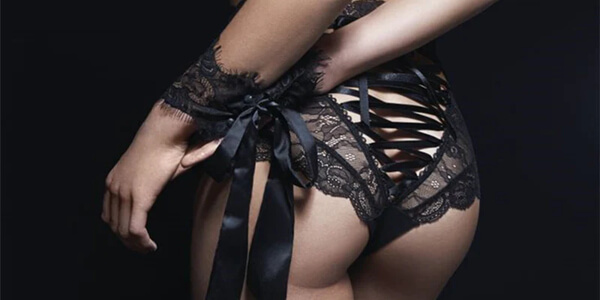
Latest Trends and Innovations in Customized Lingerie Design and Manufacturing
I. Introduction
In today's highly competitive lingerie industry, staying on top of the latest trends and innovations in design and manufacturing is essential to remain relevant and successful. Whether you're a large-scale manufacturer or a small business owner, keeping up with customers' changing demands and preferences is critical.
This post will overview the latest trends and innovations in customized lingerie design and manufacturing. From fabric innovations to design trends, manufacturing techniques, customization options, and brand case studies, this post will cover a range of topics to keep you up-to-date with the latest developments in the industry.
By the end of this post, you'll better understand the new opportunities and challenges that lie ahead, and you'll be able to implement some of the ideas presented to create more customized and successful lingerie products. So, let's dive into the latest trends and innovations in customized lingerie design and manufacturing!
II. Fabric Innovations
A. The latest fabric innovations in the lingerie industry
In recent years, the lingerie industry has seen a lot of innovations in fabrics that are being used for customized lingerie manufacturing. One of the latest innovations is using sustainable materials such as bamboo, organic cotton, and recycled polyester. These fabrics are eco-friendly and have a lower environmental impact than traditional fabrics. Another popular fabric innovation is seamless technology, which eliminates the need for seams in the garment. This creates a smooth and comfortable fit, making it perfect for lingerie.
Additionally, moisture-wicking fabrics are becoming increasingly popular in lingerie design. These fabrics are designed to remove moisture from the skin, keeping the wearer dry and comfortable. Some manufacturers also experiment with innovative materials that can change color or temperature based on the wearer's body temperature or environment.
Overall, using innovative fabrics in customized lingerie manufacturing allows for greater comfort and sustainability in the industry.
B. Benefits and drawbacks of these innovations
These fabric innovations come with their own set of benefits and drawbacks. For instance, while seamless fabrics offer a smooth, streamlined look, they may need adequate support for all body types. Similarly, moisture-wicking fabrics are great for active individuals but may not feel as soft and comfortable as traditional fabrics. It's essential to consider these factors when choosing a material for customized lingerie manufacturing and to balance the desire for innovation with the need for practicality and comfort.
C. Popular fabrics being used in customized lingerie manufacturing
Customized lingerie manufacturing has opened up new opportunities for innovative fabric choices that enhance the aesthetic appeal and offer functionality. Here are some popular fabrics being used in customized lingerie manufacturing:
1.Mesh: Mesh is a lightweight, breathable fabric often used in lingerie designs for its sheer, sexy look. Mesh is a versatile fabric that can be used for different lingerie styles, including bras, panties, and bodysuits.
2.Lace: Lace is a classic fabric used in lingerie manufacturing for its delicate and romantic look. With the advancement of technology, modern lace can be produced in various colors and designs, making it a popular choice for customized lingerie manufacturing.
3.Satin: Satin is a luxurious fabric often used in lingerie designs for its smooth, glossy finish. Satin lingerie is known for its elegance and glamour, making it a popular choice for special occasions.
4.Microfiber: Microfiber is a synthetic fabric known for its softness and stretchiness. It is often used in lingerie manufacturing for its moisture-wicking properties, making it a popular choice for activewear and sports bras.
5.Bamboo: Bamboo is an eco-friendly fabric gaining popularity in the lingerie industry due to its sustainability and comfort. It is a breathable and soft fabric perfect for lingerie designs, especially for sensitive skin.
These fabrics are just a few diverse options for customized lingerie manufacturing. With the latest fabric innovations, designers can create lingerie that looks good and feels comfortable and functional.
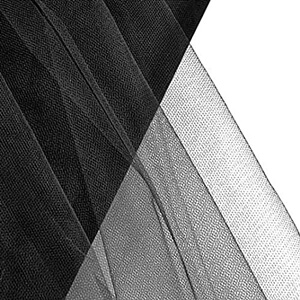
Mesh Fabric

Lace
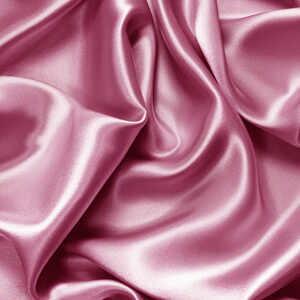
Satin
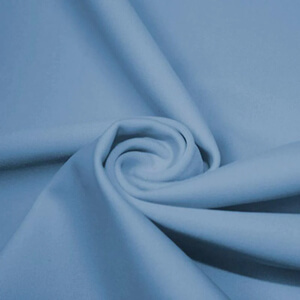
Microfiber

Bamboo
III. Design Trends
A. Current design trends in customized lingerie manufacturing
In recent years, customized lingerie has become increasingly popular among consumers looking for unique and personalized products. As a result, there has been a shift in design trends towards more individualized and customized styles.
One of the major design trends in customized lingerie is intricate detailing such as embroidery, lace, and beading. These details often create delicate and complex patterns on the underwear, adding a touch of elegance and femininity.
Another trend is the use of vibrant colors and bold prints. Consumers are no longer limited to traditional black, white, and nude shades. Instead, they opt for brighter colors and bold patterns that showcase their individuality and personal style.
Additionally, there has been a rise in the popularity of minimalist designs. Simple and sleek styles are becoming increasingly popular as consumers seek understated elegance and comfort in their lingerie.
Overall, the current design trends in customized lingerie focus on creating unique and individualized pieces that cater to the personal style and preferences of the consumer.
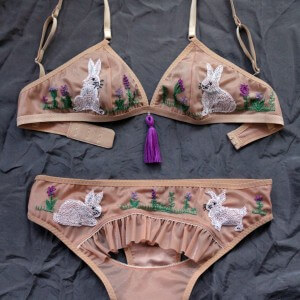
Embroidery
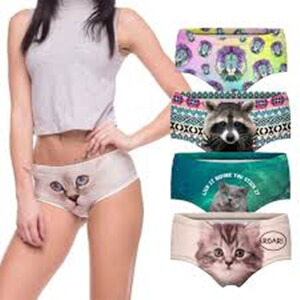
Prints

Minimalist Designs
B. Popular designs being used in the industry
High Necklines: High-neck bras and bralettes are a popular design trend, particularly for women who prefer more coverage. These designs often incorporate lace or other sheer fabrics for elegance and sex appeal.
Cutouts: Cutouts have been a popular design trend in lingerie, showing no signs of slowing down. Designers are creatively incorporating cutouts to add visual interest and create a more provocative look.
Bodysuits: Bodysuits are becoming increasingly popular in the lingerie industry. They provide a full-coverage option for women who don't want to wear a traditional bra and panty set, and they can be designed in various styles to suit different preferences.
Embellishments: From embroidery to beading, embellishments are a popular way to add visual interest to lingerie designs. They can be incorporated in various ways, from subtle accents to all-over designs.
Bralettes: Bralettes are a popular design trend, particularly for women who prefer a more comfortable, natural look. They can be designed in various styles, from delicate lace to sporty designs.
Sheer Fabrics: Sheer fabrics are a popular trend in lingerie design. They add an element of sex appeal and can be incorporated in various ways, from all-over designs to strategically placed panels.
Bold Colors and Prints: Bold colors and prints are a popular way to add personality and flair to lingerie designs. From vibrant florals to bold stripes, designers incorporate various colors and prints to suit different tastes and preferences.
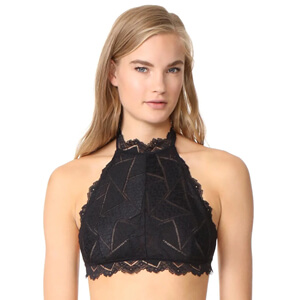
High Neck Halter Bra

Cutouts

Embellishments

Bodysuit
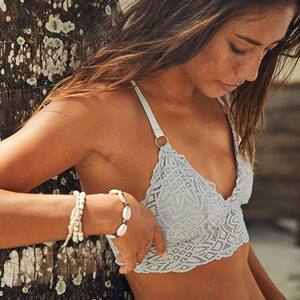
Bralette
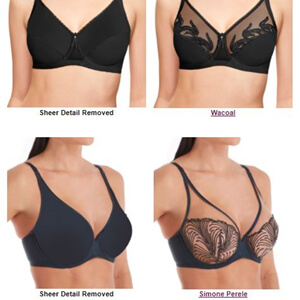
Sheer
C. Advantages and disadvantages of different design trends
When it comes to the advantages and disadvantages of different design trends in customized lingerie manufacturing, it depends on the target market and the specific brand's goals. However, there are a few general pros and cons to consider.
One advantage of using trendy designs is that they help a brand appeal to younger or more fashion-conscious customers. By keeping up with the latest styles and incorporating them into their designs, brands can create a more current and relevant image. On the other hand, if a brand relies too heavily on trends, they risk becoming outdated quickly as trends come and go.
Another advantage of customized lingerie design is that it allows for a more excellent range of styles and sizes to be offered to customers. Brands that provide a more comprehensive range of styles and sizes can appeal to a more diverse customer base, increasing sales and customer loyalty. However, creating many customized designs can also be more time-consuming and expensive than making a few standard designs in bulk.
It's also important to consider the practicality of different design trends. While certain styles may be visually appealing, they may need to be more comfortable and functional for everyday wear. This is particularly important for lingerie, which must be comfortable and supportive.
Brands should aim to create visually appealing, comfortable, and functional designs for their target customers. By doing so, they can build a loyal customer base and stay relevant in the competitive lingerie market. Ultimately, the key is to strike a balance between creating designs that are both trendy and practical.
IV. Manufacturing Techniques
A. Latest manufacturing techniques being used in the lingerie industry
Several popular manufacturing techniques are being used in the customized lingerie industry. One of them is the use of 3D printing technology. 3D printing allows for creating of intricate designs and shapes that are difficult or impossible to achieve with traditional manufacturing methods. It also reduces waste and speeds up the production process. However, some drawbacks are the high cost of 3D printing technology and the limited range of materials that can be used.
Another popular technique is laser cutting. Laser cutting uses a focused laser beam to cut and shape the fabric, resulting in precise and clean cuts. This technique allows for the creation of complex designs with intricate details. It also reduces fabric waste and improves efficiency. However, some disadvantages are the high initial investment cost of the equipment and the potential for damage to the fabric.
Other manufacturing techniques being used in the industry include heat sealing, ultrasonic bonding, and digital printing. Heat sealing uses heat and pressure to seal fabrics together without thread or adhesives, resulting in a seamless and streamlined finish. Ultrasonic bonding uses high-frequency vibrations to bond materials together, eliminating the need for sewing and improving strength and durability. Digital printing allows for the creation of custom prints and designs and reduces the time and cost of producing samples. However, the limited range of materials that can be used and the potential for color fading are some drawbacks of digital printing.
Additionally, there is a growing trend toward using digital technologies to streamline the manufacturing process. This includes using computer-aided design (CAD) software to create and refine designs, as well as using automation and robotics to speed up production and reduce errors.
Overall, these techniques offer a range of benefits, such as increased efficiency, reduced waste, and more precise manufacturing. However, they also require significant investment in technology and expertise and may only be suitable for some types of lingerie manufacturing.
B. Advantages and disadvantages of these techniques
The latest manufacturing techniques used in the lingerie industry offer several advantages and some drawbacks. One of the advantages is increased efficiency, allowing for a faster production process and lower costs. For example, computer-aided design (CAD) software has made it easier to create digital designs, which can be quickly converted into physical prototypes using 3D printing.
Another advantage is improved precision and accuracy in the manufacturing process, which is essential when producing customized lingerie. Laser cutting technology, for instance, can cut fabrics with greater accuracy than traditional methods, resulting in a more precise fit for the wearer.
However, these manufacturing techniques also have some drawbacks. For example, some of the newer technologies require specialized skills and training, which can increase labor costs. Additionally, the equipment needed for these techniques can be expensive, which may not be feasible for smaller manufacturers.
While the latest manufacturing techniques offer many benefits, manufacturers must carefully consider the costs and potential drawbacks when deciding which practices to adopt.
V. Customization Options
A. Discussion of the different customization options available in the lingerie industry
Customization options are becoming increasingly popular in the lingerie industry as consumers seek more personalized and unique products. Some customization options available include size, color, material, and style.
Size customization allows customers to select their measurements to ensure a perfect fit. This option is particularly beneficial for those with difficulty finding lingerie that fits appropriately in standard sizes.
Color customization allows customers to choose from a range of colors and patterns, allowing them to match their lingerie to their style or mood.
Material customization allows customers to choose from various fabrics to suit their preferences, such as silk, cotton, or lace.
Style customization allows customers to select specific design elements, such as the type of straps, closures, or embellishments.
Overall, customization options allow customers to create a lingerie piece that is uniquely theirs and reflects their taste and style. However, it's important to note that customization may come with a higher price tag and longer lead times due to the need for specialized manufacturing processes.
B. Advantages and disadvantages of different customization options
Customization options in the lingerie industry have increased dramatically in recent years, offering consumers more choices. Customizing lingerie has several advantages, including a perfect fit, increased comfort, and the ability to express one's personal style. However, there are also some drawbacks to consider.
One advantage of customization options is the ability to choose the perfect fit. This is particularly important in the lingerie industry, where the right fit can make all the difference in comfort and confidence. Customized lingerie can also provide more significant support, particularly for women with larger busts or unusual proportions.
Another advantage is the ability to express one's style. Customized lingerie can feature unique colors, patterns, and designs unavailable in standard off-the-rack options. This can be particularly appealing for those who want lingerie that reflects their individuality.
However, there are also some potential drawbacks to customization. One is the cost, as customized lingerie is often more expensive than standard options. Additionally, the customization process can be time-consuming, particularly for those who need help with their preferences or require multiple fittings.
Overall, the advantages of customization in the lingerie industry may outweigh the drawbacks, particularly for those who prioritize a perfect fit and unique style. Consumers must weigh the pros and cons carefully and choose the customization options that best suit their needs and preferences.
C. Examples of popular customization options being used in the industry
Customization options in the lingerie industry are becoming increasingly diverse, with brands and manufacturers offering various options to suit different needs and preferences. Here are some popular customization options being used in the industry:
1.Color and Print: Color and print customization allows customers to choose the color or print they prefer for their lingerie. This customization option is popular among customers who want to match their underwear with their outfits or style.
2.Size and Fit: Lingerie brands and manufacturers now offer size and fit customization options. This allows customers to provide their measurements and receive lingerie that fits them perfectly. This customization option is popular among customers who have difficulty finding lingerie that fits them well.
3.Embellishments: Some brands and manufacturers offer customization options for decorations, such as lace, beading, and embroidery. This allows customers to add a personal touch to their lingerie and make it more unique.
4.Fabric and Material: Fabric and material customization options allow customers to choose the fabric or material they prefer for their lingerie. This customization option is popular among customers with specific fabric preferences, such as silk or cotton.
5.Style and Design: Customers can choose various styles and designs when customizing their lingerie. This customization option is popular among customers who want lingerie that suits their taste and style.
While customization options offer many benefits, there are also some drawbacks. Customized lingeries may be more expensive than standard ones, and the customization process can take longer. Not all brands and manufacturers offer customization options, so customers may have limited options depending on where they shop.
Overall, customization options in the lingerie industry provide customers with greater flexibility and the ability to create lingerie that suits their needs and preferences.
VI. Brand Case Studies
A. Overview of successful brands in the customized lingerie industry
In recent years, the customized lingerie industry has seen the emergence of several successful brands that have captured a significant market share. These brands have been able to differentiate themselves from their competitors by offering their customers unique and personalized lingerie options. Some of the most successful brands in the customized lingerie industry include:
Adore Me: Founded in 2012, Adore Me has quickly become one of the most successful lingerie brands in the industry. The company's focus on offering high-quality lingerie at affordable prices and its emphasis on customization options has helped it attract a large customer base.
ThirdLove: Launched in 2013, ThirdLove is a San Francisco-based lingerie company specializing in creating perfectly fit bras. The company's innovative approach to sizing has helped it attract a loyal customer base that appreciates the attention to detail and customization options available.
True&Co: Founded in 2012, True&Co is a lingerie brand that focuses on providing personalized recommendations to its customers. The company's Fit Quiz is a unique feature that has helped it stand out in the industry, as it allows customers to find the perfect fit based on their body type and style preferences.
Naja: Naja is a sustainable lingerie brand that was founded in 2013. The company's focus on eco-friendly manufacturing processes and its wide range of customization options have helped it attract a loyal customer base.
These brands have succeeded in the customized lingerie industry by offering unique and personalized options to their customers. They have differentiated itself from competitors by providing high-quality products tailored to its customer's needs and preferences.
B. Analysis of their strategies and what makes them successful
There are several strategies that successful brands in the customized lingerie industry have used to stand out and attract customers.
Firstly, many of these brands have prioritized sustainability in their manufacturing processes, using eco-friendly materials and reducing waste. This has become increasingly important to consumers who are becoming more conscious of their impact on the environment.
Secondly, successful brands have focused on inclusivity, offering various sizes and styles to cater to different body types and preferences. They have also tried to feature diverse models in their advertising campaigns, promoting body positivity and challenging traditional beauty standards.
Thirdly, some successful brands have implemented technology to enhance the customization experience for their customers. For example, some companies use virtual reality or 3D scanning to create a more accurate and personalized fit for their customers.
Lastly, successful brands have established a solid online presence and utilized social media platforms to reach a wider audience and engage with customers. They have also offered excellent customer service and created a community through their branding and marketing efforts.
By implementing these strategies, successful brands have been able to differentiate themselves in a competitive market and build a loyal customer base.
C. How smaller brands can learn from these successful brands
Smaller brands in the customized lingerie industry can learn several lessons from the success stories of established brands. Firstly, it is essential to identify and cater to a specific target market. By doing so, brands can create a niche and establish a loyal customer base. For example, brands like Savage X Fenty and Adore Me have gained popularity by targeting diverse body types and skin tones, which traditional lingerie brands often neglect.
Secondly, technology plays a crucial role in the success of modern lingerie brands. Advanced manufacturing techniques and customization options allow brands to offer unique and personalized products to their customers. Additionally, using social media and influencer marketing has proven to be an effective strategy for brands to reach a wider audience.
Another important lesson is to prioritize sustainability and ethical practices. As consumers become more conscious about the impact of their purchases on the environment and society, brands that prioritize ethical and sustainable practices are more likely to gain their trust and loyalty. For instance, brands like Naja and Lively have gained recognition for their sustainable and ethical rules.
Lastly, creating a positive and inclusive brand image is crucial for success in the modern lingerie industry. Brands prioritizing inclusivity, diversity, and body positivity will more likely resonate with customers and establish a positive reputation. For example, ThirdLove has gained recognition for its focus on offering a wide range of sizes and its "To Each, Her Own" campaign, which celebrates individuality and diversity.
By learning from these successful brands and adopting similar strategies, smaller brands in the customized lingerie industry can establish themselves in the market and gain a competitive edge.
VII. Conclusion
In conclusion, the customized lingerie industry is a growing market with great potential for innovation and growth. With advancements in fabric innovations, design trends, manufacturing techniques, and customization options, consumers can enjoy lingerie tailored to their preferences and needs.
Successful brands in the industry have implemented various strategies to differentiate themselves from competitors and offer unique value propositions to their customers. Smaller brands can learn from their success and focus on creating a solid brand identity, investing in quality materials and craftsmanship, and leveraging technology to improve their customization offerings.
The future looks bright for the customized lingerie industry as more consumers seek personalized and sustainable options. As the industry evolves, it will be interesting to see what innovations and trends emerge in the coming years.
